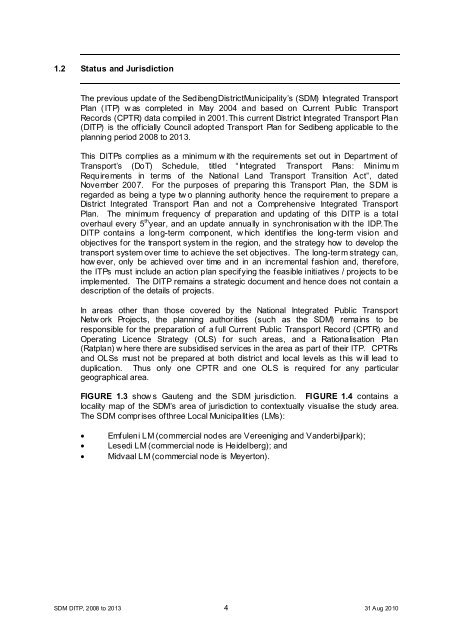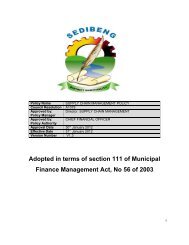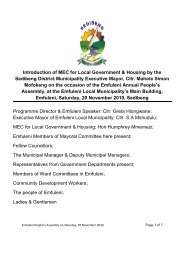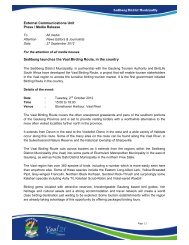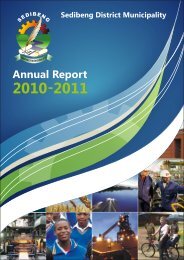Chapter 11 - Sedibeng District Municipality
Chapter 11 - Sedibeng District Municipality
Chapter 11 - Sedibeng District Municipality
You also want an ePaper? Increase the reach of your titles
YUMPU automatically turns print PDFs into web optimized ePapers that Google loves.
1.2 Status and Jurisdiction<br />
The previous update of the <strong>Sedibeng</strong><strong>District</strong><strong>Municipality</strong>’s (SDM) Integrated Transport<br />
Plan (ITP) w as completed in May 2004 and based on Current Public Transport<br />
Records (CPTR) data compiled in 2001.This current <strong>District</strong> Integrated Transport Plan<br />
(DITP) is the officially Council adopted Transport Plan for <strong>Sedibeng</strong> applicable to the<br />
planning period 2008 to 2013.<br />
This DITPs complies as a minimum w ith the requirements set out in Department of<br />
Transport’s (DoT) Schedule, titled “Integrated Transport Plans: Minimu m<br />
Requirements in terms of the National Land Transport Transition Act”, dated<br />
November 2007. For the purposes of preparing this Transport Plan, the SDM is<br />
regarded as being a type tw o planning authority hence the requirement to prepare a<br />
<strong>District</strong> Integrated Transport Plan and not a Comprehensive Integrated Transport<br />
Plan. The minimum frequency of preparation and updating of this DITP is a total<br />
overhaul every 5 th year, and an update annually in synchronisation w ith the IDP.The<br />
DITP contains a long-term component, w hich identifies the long-term vision and<br />
objectives for the transport system in the region, and the strategy how to develop the<br />
transport system over time to achieve the set objectives. The long-term strategy can,<br />
how ever, only be achieved over time and in an incremental fashion and, therefore,<br />
the ITPs must include an action plan specifying the feasible initiatives / projects to be<br />
implemented. The DITP remains a strategic document and hence does not contain a<br />
description of the details of projects.<br />
In areas other than those covered by the National Integrated Public Transport<br />
Netw ork Projects, the planning authorities (such as the SDM) remains to be<br />
responsible for the preparation of a full Current Public Transport Record (CPTR) and<br />
Operating Licence Strategy (OLS) for such areas, and a Rationalisation Plan<br />
(Ratplan) w here there are subsidised services in the area as part of their ITP. CPTRs<br />
and OLSs must not be prepared at both district and local levels as this w ill lead to<br />
duplication. Thus only one CPTR and one OLS is required for any particular<br />
geographical area.<br />
FIGURE 1.3 show s Gauteng and the SDM jurisdiction. FIGURE 1.4 contains a<br />
locality map of the SDM’s area of jurisdiction to contextually visualise the study area.<br />
The SDM comprises ofthree Local Municipalities (LMs):<br />
• Emfuleni LM (commercial nodes are Vereeniging and Vanderbijlpark);<br />
• Lesedi LM (commercial node is Heidelberg); and<br />
• Midvaal LM (commercial node is Meyerton).<br />
SDM DITP, 2008 to 2013 4 31 Aug 2010


